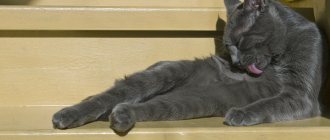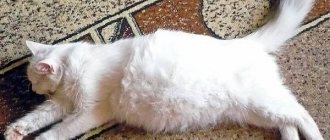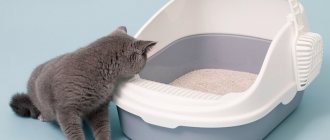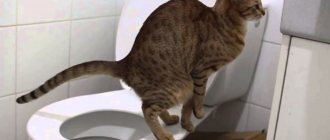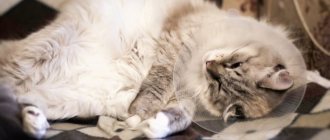Diseases of the teeth and oral cavity in cats
If a cat's lower jaw is swollen, first of all the cause should be looked for in various pathologies of the oral cavity. In old age, animals develop dental diseases: over time, they decay, soften, and begin to loosen. Small cracks in the enamel provoke the development of caries, which ultimately leads to tooth decay.
Its roots are located deep in the gums, damage to the front molars leads to compactions in the chin area. Key signs of pathology:
- refusal of usual food;
- moving the mouth to the side;
- lethargy and weakness;
- absence of painful sensations when palpating the problem area.
Additional signs that should alert owners
With the development of severe diseases, an increase in the lower jaw is often accompanied by additional symptoms. Knowing what to look for, you will be able to react correctly - contact a veterinarian and undergo a course of therapy. If a cat's lower jaw is swollen, the following signs should alert you:
- an unpleasant smell of rotting or pus appears from the oral cavity;
- the swelling has a dense, hard structure; when pressed, the cat shows that it is in pain and does not allow the formation to be touched;
- the animal refuses to take food, it is thirsty because the cat does not drink;
- small transparent blisters with purulent contents appear on the oral mucosa;
- body temperature rises, the pet becomes lethargic and looks sick;
- cloudy mucus flows from the nose and eyes.
It is difficult to determine what causes such manifestations on your own, so it is not recommended to use any drugs or home remedies without preliminary diagnosis. Only if it is known for sure that the tumor was caused by an insect bite, the introduction of solid food into the diet, or an allergy, can you do without the help of a veterinarian.
Skin pathologies in cats
Common causes of tumor-like formations include subcutaneous pimples (acne). The main place of their localization is the corners of the mouth. The dermatological neoplasm does not cause discomfort to the animal, but becomes a source of problems with normal food intake.
If your pet's lower jaw is swollen, this may be due to:
- increased secretion production by the sebaceous glands;
- insufficient care for the pet’s oral cavity;
- using utensils made of low quality plastic;
- hormonal imbalance.
To get rid of acne, wash the chin area with antibacterial soap. Then an ointment containing benzoyl peroxide is applied to the affected area. To avoid licking off the medication, the owner is advised to hold the pet for 5–7 minutes.
After therapeutic procedures, the chin and affected lip are treated with a weakly concentrated solution of chlorhexidine. To prevent acne, it is recommended to feed your pet from ceramic or glass dishes, carefully treating them after each meal.
Odontogenic osteomyelitis
If the cat refuses to eat and looks lethargic, this indicates the development of the disease.
The causative agent is Staphylococcus aureus. Inflammation affects all bone structures and bone marrow of the lower jaw.
The main factor in the development of osteomyelitis is considered to be advanced gingivitis, abscess, periodontal disease, wounds through which infection entered, and incorrectly performed dental procedures. In advanced cases, the cat will not live long.
Symptoms:
- local and general hyperthermia;
- lethargy, refusal to play and eat;
- increased thirst;
- the appearance of a fistula on the jaw, from which pus is released;
- heart rhythm disturbance;
- enlargement of local lymph nodes;
- redness, swelling;
- the appearance of areas of necrosis.
Tumor as a reaction to an insect bite
Constant walks in the fresh air lead to contact with insects. A sign of a bite is a sharp swelling of the lip, the animal’s attempts to scratch the affected area, and attracting the owner’s attention with a drawn-out meow. First aid is to use Suprastin, Loratadine. Successful treatment results in reduced swelling within a few hours.
Wasp and bee stings become deadly for an animal prone to allergic reactions. The owners need to take the cat to the veterinary clinic quickly, before angioedema develops.
Detailed overview of possible causes
If your cat's lower jaw is swollen after recent problems with teeth or gums, then you need to rule out the possibility of an abscess or fistula, which can form due to tartar or chronic gum disease. There is also a possibility that the abscess will be localized directly on the jaw itself due to infection under the skin or a foreign body. Any swelling not associated with injury is best shown to a veterinarian to rule out the following possible pathologies:
- Tooth root cyst. Because of it, a cat's lower jaw can swell to a significant size. At the same time, the tooth itself may look absolutely healthy. In such cases, an x-ray of the entire jaw will be required. If the problem is truly a cyst, then the affected tooth must be removed. The hole is cleaned, treated with an antiseptic, if there is pus, drainage is applied. After removal, the oral cavity must be sanitized by rinsing with chlorhexidine 2-3 times a day for a week.
- Stinging insect bite. If a cat's lower jaw is swollen after a wasp or bee sting, then you should carefully monitor the pet's condition for at least several hours after the incident. Typically, swelling after stinging insect bites goes away within 1-2 hours. But, if there are signs of shortness of breath or a change in the color of the mucous membranes of the mouth (turn blue or white), then the animal should be taken to the nearest veterinary clinic as soon as possible. In some cases, stinging insect bites can cause anaphylactic shock and lead to suffocation.
- Eosinophilic granulomas. They can appear not only on the outside of the jaw, but also on the inside of the mouth and gums. On the outside, the formations will look like small pink swellings; on the inside, they look more like ulcers that can reach the size of a large coin. There is a possibility that external sores will go away on their own or after changing the brand of food. Ulcers on the mucous membrane must be dealt with, as they bring significant discomfort to the pet while eating. Hormonal and antihistamines can be used for this.
- Hematoma. If a cat's lower jaw is swollen after a blow or fall from a height, then consider the option of a hematoma - a formation within which blood clots accumulate. Hematomas can reach significant sizes, so in some cases they have to be opened and the contents pumped out, followed by antiseptic treatments. Small hematomas are treated with anti-inflammatory and regenerating ointments. They pass within 3-7 days.
- Tumor. If an old cat has a swollen lower jaw, then first of all the possibility of developing malignant tumors is excluded. Unfortunately, even timely detection of sarcoma or lymphoma provides only a slim chance of a favorable prognosis. This can be explained by the peculiarity of the localization of the tumor and the impossibility of carrying out its full excision with the recommended capture of healthy tissue within 3-5 cm. Therefore, in most cases, symptomatic treatment is offered, aimed at improving the general condition of the animal. To make a diagnosis, an MRI of the head and x-rays of organs and lymph nodes into which metastases can grow are mandatory. A puncture is taken from the tumor itself with a thin-bore needle and the resulting materials are sent for histological examination, based on the results of which an effective treatment method is selected - radiation or chemotherapy.
- Dental problems. Even a young cat can have a swollen lower jaw if the rotten root from the gum is not removed in time. Such cases occur with any breed at any age. Animals, even at a young age, can break off their teeth at the root after a fall from a great height or a strong blow. The roots must be removed in order to avoid an inflammatory process that affects the gums, and in some cases even the bone. The removal process itself takes several minutes and is carried out under anesthesia or pain relief (decided by the attending physician).
If an old cat's lower jaw is swollen not due to a tumor process, then there is a high probability that the problem is associated with tartar, an abscess on the gum, a fistulous tract, or a granuloma. All of the above are common in pets over the age of 10 years.
Often, cat owners may notice that their pet's chin is swollen. A swollen chin often has a spherical shape. Without a veterinary examination, it is impossible to determine whether a lump is considered a symptom of a serious illness or not.
Allergic edema
A lip swelling without traces of an insect bite indicates an allergy. Swelling forms a few minutes after the pet comes into contact with the allergen. The complex course of allergic reactions leads to swelling of the entire muzzle of the animal and requires a visit to the veterinarian. The problem of mild swelling can be solved with the help of antihistamines.
Regardless of the level of the allergic reaction, you should not put off going to the veterinary hospital: doctors will determine the cause of the disease and recommend the best remedy for the future. In some pets, swelling on the chin is associated with eosinophilic granuloma, an inflammatory process that resembles a common allergy. The sources of its occurrence are unknown; there is a theory about the hypersensitivity of the body, which provokes the development of pathology.
Symptoms
If a wart is just about to appear in a cat, then the preceding symptoms can be called (they indicate the presence of papillomavirus in the animal’s body):
- decreased appetite;
- the appearance of itching and discomfort (due to the cat scratching the itchy surface, bleeding wounds appear);
- lethargy;
- initial manifestation of single or interconnected tumors.
It must be remembered that if you see a suspicious growth on the neck, chin or other part of the body, the owner must bring the pet to the doctor. Only a veterinarian can make an accurate diagnosis and prescribe treatment. To adjust measures to combat fibropapillomas, the doctor can take a general blood test from cats and prescribe a biopsy of the new tumor.
It is important to know! Below is a list of measures aimed at combating warts. You should not take risks and self-medicate your pet. This list is provided for informational purposes only.
Swelling after a bruise
The formation of a hematoma is considered to be the cause of tissue swelling on the chin. Its formation is preceded by weak blows and accidental falls of the pet. First aid involves applying cold to the injury site: a small piece of ice wrapped in cotton cloth.
Before the procedure, the pet is carefully examined to exclude dislocations and other injuries. The pathology occurs in active and young animals; their owners need knowledge of emergency care rules and a supply of antiseptic solutions.
Neoplasms: benign and malignant
Oral cancer in cats is rare. Doubts arise if the pet is over 13 years of age; the animal requires a comprehensive diagnostic examination.
No specific signs of malignant neoplasms were found; the standard ones include lethargy and refusal of the usual food. The diagnosis is made after evaluating an x-ray image and a blood test for hidden inflammatory processes. If the disease is confirmed, an operation is performed to remove the cancerous formation, and the collected material is sent for histological examination. Additionally, a course of chemotherapy is prescribed.
Osteosarcoma and squamous cell carcinoma are determined by severe pain. The pet avoids touching the affected areas and is unable to drink or chew food on its own. Sometimes animals are fed using a syringe.
The structure of the swelling can tell us about the reasons for its formation. If a hard lump is felt under the fingers and the animal tries to escape, then a cyst has formed. It appears with dental diseases and consists of overgrown bone tissue in the chin area.
If the structure of the neoplasm is heterogeneous and soft, an abscess is suspected. The pathological process occurs when infectious microflora invades the oral cavity. The problem is due to the penetration of bacteria to the roots of the teeth. An abscess is removed surgically, and in some pets it breaks out on its own. If the latter is opened without outside help, then the owners carry out aseptic washing several times a day in order to prevent secondary infection. After the operation, the animal is prescribed a course of antibacterial drugs.
A tumor in the chin area of a cat requires a visit to the veterinary clinic and identification of the causes of its occurrence. In some animals, the problem is associated with enlarged lymph nodes. Pathology is observed with dysfunction of the immune system, insufficient supply of vitamins and minerals. A sick pet is recommended to switch to an appropriate diet and take multivitamin supplements.
Lipoma
One common method is surgical removal of the formation, which may be behind the ear, on one side of the neck. But if the area where the lump appears is dangerous, and the lump itself remains its size for a long time, the veterinarian may recommend not to eliminate it.
But the appearance of a wen on the neck or other part of the body can unnerve the cat and make it want to scratch the growth. In this case, it is better to remove the cone so that its cells do not undergo the process of degeneration. Removal is performed in most veterinary clinics; dressings can be done at home or also at the doctor's office. The skin heals quickly, and in the future the animal will not suffer due to the interfering growth.
Even experienced cat owners and breeders cannot accurately determine the type of neoplasm on a cat’s neck; this requires veterinary education and modern diagnostic and laboratory equipment. The pet owner’s task is not to ignore the problem of his animal for a long time.
Diagnostics and treatment measures
The bumps your pet may have are divided into:
- Small;
- Average;
- Big ones.
Small ones are simple pimples. They arise as a result of insufficient hygiene. You can get rid of them by wiping the problem area with hydrogen peroxide.
In the case of cat acne, you need to eliminate excess sebum and prevent secondary infection. For mild skin lesions, use antibacterial soap and iodine solution (treat infected areas 2-4 times a day). For a more serious form of the disease, it is necessary to resort to the use of medicinal ointments and gels based on benzoyl.
The diameter of medium cones is 2-5 mm. They are distinguished from acne by their denser structure and the presence of pus.
Large ones indicate a serious illness. Therefore, if your cat’s chin is very swollen, you should not delay a visit to the veterinarian. Each missed day reduces the chance of a favorable outcome.
Treatment of insect bites is carried out using an antihistamine (such as suprastin and cetrin), in combination with glucorticoids (dexamethasone). If a severe toxic reaction is observed, outpatient treatment with intravenous drips and oxygen inhalation will be required.
What to do to treat snake bites? In this case, it is important to remove the poison that has entered the body.
In this case it is prohibited:
- trying to suck the poison out of the wound (this is a waste of time, there will be no less poison, and time will be wasted);
- apply a tourniquet to the bite;
- cauterize the wound (inflammation will be provoked, but the amount of poison will not decrease).
You need to use the antidote immediately. At the same time, you should monitor the likelihood of an allergic reaction on the inside of the ears. If redness appears in the auricle, then a joint injection of diphenhydramine and an antidote should be given. The dose of medicine depends on the severity of the bite. It is possible to reduce it after reducing pain and normalizing blood clotting processes.
When your pet feels better, you need to give him broad-spectrum antibiotics. In this way it is possible to suppress secondary infection.
The tumor can only be treated with surgery. The chance that the animal will fully recover with it is zero. However, after the operation, the pet will live for several more years.
Abscess
Abscesses appear after insect bites of a certain type (Notoedrosis develops), after an unsuccessful injection, when an infection gets into the skin puncture site. Suppuration begins under the skin, and anaerobic flora multiplies. The cat has many problems in connection with such formations on the body, because abscesses are quite painful, can raise the temperature and cause fever.
A small abscess can be treated at home if you are sure that the problem has been correctly diagnosed.
- First, the affected area is disinfected, then the purulent fluid is carefully removed from the wound.
- The next step is to wash the wound with hydrogen peroxide.
- When the wound is refilled with fluid, it must be cleaned again.
Malignant neoplasms
Oral cancer is not common, but in three out of a hundred cats it causes growths in the area where the whiskers grow. Therefore, if your cat has a bump on its cheek, contact your veterinarian.
The cause of this serious disease is frequent smoking by the owner in the presence of the pet, and unnatural nutrition based on canned cat food. The most common diagnosis is squamous cell carcinoma or fibrosarcoma.
Treatment of such diseases is not carried out at home; surgical removal of the bump on the cheek is prescribed. Chemotherapy is used to prevent metastases. However, with a progressive tumor and advanced disease, the cat cannot be cured.


